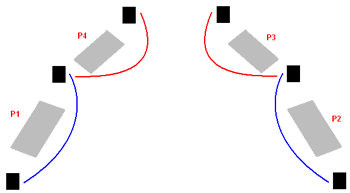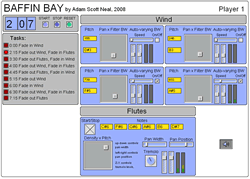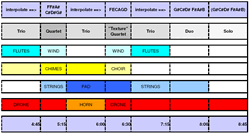A Continuum of Indeterminacy in Laptop Music
Adapted from the author’s 2008 MA Dissertation at Queen’s University Belfast.
1. Introduction
The laptop ensemble (sometimes dubbed “laptop orchestra” depending on its size) is an exciting new type of ensemble emerging all over the world. The aural and interactive possibilities afforded by these ensembles are attractive to composers, but many of the performances by these groups favour improvisation over composition.
As a composer, I have been fascinated by the potential of these ensembles, but some questions come to mind:
Are improvised pieces better for these groups, since many participants are not trained musicians?
Since computers allow so much precision, what is the purpose of having performers?
How much control can the composer impose before the piece becomes boring for the performers?
How little control can the composer impose before the piece ceases to be a “composition”?
This project includes five compositions for laptop quartet which explore a continuum between deterministic composition and pure improvisation. Each piece encourages exploration and expression while controlling form and ensemble interaction in order to create coherent and identifiable compositions. In this abbreviated report, I will discuss three of the five works: Presets, (Not) For Tape, and Baffin Bay. Presets is fully improvised, but informed by the provided interface and network processes. (Not) For Tape has an indeterminate form but a restricted sound palette. Baffin Bay has a predetermined form, timbres and pitch material, but still allows a moderate amount of improvisation.
2. A Continuum of Indeterminacy
In electroacoustic music, a composer has tremendous control over sounds, their spatialization, and their temporal structure. A piece that is too deterministic in these respects would not require human performers, but instead could exist in a fixed form on tape or disc. In contrast, acoustic music requires performers to realize a composer’s intended sounds. Since humans are not as precise as computers, there will always be a degree of indeterminacy when a piece is performed.
Indeterminacy in regards to performance is not necessarily negative; it is often expected. MIDI recordings follow scores exactly, but they sound inhuman because of their precision. Humans add fluctuations in tempo, rhythm, intonation, etc. (sometimes unknowingly), which adds another layer of interest to the work. These aspects are often described as “interpretation” or “expression,” but the most inclusive term would simply be “indeterminacy.” In Silence, Cage (1968) mentions Bach’s The Art of Fugue as an example of music which is indeterminate in performance; the rhythm and pitch structures are determined but dynamics and timbre are not. In any composition, the performer “fills in color where outlines are given.”
Eco’s (1989) conception of the composer-performer relationship was that a composer offers the performer a work “to be completed.” According to Reynolds (1965), the composer’s job is to propose an “occasion for experience.” The amount of detail in that proposal varies from composer to composer and from work to work.
2.1 What Constitutes a Work?
In order for us to recognize a piece of music as a composition, rather than an improvisation, the piece must possess a recognizable “identity”. Several writers have cited this, including Dahlhaus (paraphrased in Lewis, 1996), Benson (2003) and Levinson (1980). Benson, citing Charles Peirce, notes that a work is a type and that all performances of that work are tokens, or incomplete realizations. There are numerous recordings (tokens) of Beethoven’s Ninth Symphony (type) because each token has different qualities, and none will ever capture all of the possible qualities of the Ninth. The idealized Ninth exists only in our minds, but each token is still recognizable as the Ninth.
Beethoven’s writing is fairly detailed, at least compared to graphic score composers. He is less detailed than New Complexity composers, or acousmatic composers. While there is obviously a continuum in the amount of detail proposed by the composer, we still need a definition of “composition.” My working definition, which I hope will be as inclusive as possible, is this: a composition is a proposal for experience which maintains a recognizable identity during each iteration.
2.2 Elements that Create Identity
Three elements that create a work’s identity are form, fixity of personnel, and the concept or method of execution. Each of these categories is broad, and of course there could be more. The form is the scale and proportions, articulated by tempi, texture, harmony, etc. The “fixity of personnel”, a term used by Emmerson (2000), includes the timbres chosen by the composer (instruments in acoustic music, synthesis or processing techniques in electroacoustic music). A third element is the method of execution, which could range from fixed-media works on the determinate end of the continuum to improvisation frameworks on the indeterminate end.
These three elements will have different degrees of determinacy in each piece. For example, the “open works” cited by Eco (Stockhausen’s Klavierstück XI, Boulez’s Third Piano Sonata, and Pousseur’s Scambi) have indeterminate form, but are still considered “works/compositions”. There are directions for creating the form (method of execution) and relatively predetermined sound worlds (fixity of personnel).
3. Case Study: Portfolio of Five Works
To study this continuum of indeterminacy in laptop music, I created five works for laptop quartet. A quartet was more feasible than an orchestra, given my limited time and resources. However, these pieces still effectively demonstrate different points along the continuum, and different ratios of the three elements of identity. Below are descriptions of three of the works, as well as evaluations of the works, using a 1–10 scale for each of the three elements.
3.1 Implementation

All of the pieces in this portfolio were programmed in Max/MSP. In addition to the objects native to Max/MSP, I used two third-party extensions: the “mmmlist” external by Jasch and the Frequencyliator, a patch created by Alain Renaud at SARC (which uses several of CNMAT’s Open Sound Control externals).
I decided to create interfaces which required only the mouse and QWERTY keyboard available on the computer. The only extra pieces of equipment required are audio interfaces and a PA system. I hope that the ease of implementation will invite more opportunities for performance.
Figure 1 shows a diagram of our setup for the first concert of these works, in the Sonic Lab at the Sonic Arts Research Centre. I used the front six channels of an octophonic system, forming a wide arc. Each performer has stereo output, but two of the speakers are shared. This allowed us to sit as a (widely-spaced) chamber ensemble, and created a wide field of sound which aided the audience in identifying the sounds created by each performer.
3.2 Baffin Bay
3.2.1 Program Note
Baffin Bay is a body of water between Greenland and Baffin Island, Canada. Near the Arctic Ocean, it is a cold, forbidding, but beautiful place. I have never visited, but I have long been fascinated by the arctic seascape and its indigenous wildlife. This relaxed and contemplative work was written for laptop quartet, and each player is assigned two instruments for a total of eight unique instruments. The form is based around four quartets featuring different combinations of these instruments, as well as duos and trios building up to and receding from these quartets. The players improvise within a structure that determines who will play at a given time, and what pitches will be present at that time.
3.2.2 Implementation
In this piece, each of the four players is provided with a unique patch which contains two “instruments”. On the left side of their patch is a clock and a list of “tasks”. The tasks are essentially the score — they tell the players when to fade in and fade out certain sounds. Otherwise, the players are free to improvise with the provided patches. Figure 2 shows a screenshot of the patch for Player 1.

At the opening of the piece, all the players start their clocks and await their designated time to begin. The patches themselves control which pitches are available to the players, so the players’ improvisation primarily affects density and dynamics. The form of the piece is defined by the sonorities projected by the instruments as well as the presence of the instruments. The formal graph below displays the pitches available in each section, as well as what instruments are requested. The central points are the quartet sections, most importantly the “melodic” quartet at 2:15 (all melodic instruments), and the “texture” quartet at 6:00 (all texture-based instruments).


3.2.3 Evaluation
For each piece, I have evaluated the elements of identity on a 10-point scale, with 1 being the least determinate and 10 being the most determinate. This scale is entirely subjective and is used for demonstration only.
Form — 7/10
Due to the enforced timing of pitch material and “orchestration”, this form is fairly determinate. However, surface gestures are indeterminate.
Fixity of personnel — 8/10
This is very determinate, as each performance will feature the same eight “instruments”.
Concept/method — 8/10
While the players are encouraged to improvise, their instruments are very limited (particularly in regards to pitch). The method of using the laptop interface to affect density, register, etc. is very determinate.
Average amount of determinacy: 76%
Audio example 1 presents two excerpts from the same point in the timeline of Baffin Bay. The first excerpt is from the premiere performance, the second is from the studio version. Although the surface gestures change, there is still a sense that this is the same point in the piece.
3.3 (Not) For Tape
3.3.1 Program Note
Since an early medium for composing electronic works was magnetic tape, many concert programs describe a piece as written “for tape”, much like a piece might be written “for piano”. This tradition persists today, despite the fact that most pieces are no longer presented from tape, but rather from digital media (e.g. hard disk). This piece is performed by four musicians, rather than simply presented from fixed media such as disk or tape. However, the source sounds of the piece are adhesive tape, so the piece is both “for tape” and “not for tape”. As an homage to early works for tape, I relied on sound manipulations used since the early days of musique concrète, namely speed manipulation, filtering, reverberation, and ring modulation. Again, there is no fixed form for this work. To further remove this piece from fixity, the players are presented with a graphic score that can be interpreted in multiple ways, rendering each performance substantially different.
3.3.2 Implementation
The score was made directly in the patch with number boxes of various colours. Players may navigate through the score in any way they wish, but I constructed the score to increase the likelihood that specific sounds would occur at certain times. For example, the only instances of number 6 are in the centre of the score, so it is likely that several players will converge on this area at roughly midway through the piece. There are also areas on the left and right which feature certain numbers (4 and 5 on the left, and 9 and 0 on the right). The number 1 occurs in the centre as well as in the corners, ensuring a high likelihood, although not a certainty, that the piece will begin and end with sound number 1.

The colour codes do not mean anything specific, but provide a memory aid for the players. When the player presses a number, the cursor on the colour swatch in their patch will move to that general area. By seeing the colour before they press a number, the players can be prepared to grab the cursor as soon as the sound begins. Some of the sounds are quite short, so if the player is searching for the cursor, he may miss the opportunity to manipulate the sound.
Since the Max/MSP colour swatch outputs red, green, and blue values, the object can be used to manipulate three variables at once. For each number, I created a unique combination. For example, with number 1, the cursor will move to yellow, and then the player can move it in any direction. If the player moves the cursor in a direction that adds more red, the amplitude increases. If the player moves the cursor in a direction that adds more green, the high pass cut-off frequency increases. Adding more blue increases the playback speed. All of these changes can happen simultaneously. If the cursor is directly over red, that means that there is little green or blue, so the playback speed is slow and the cut-off frequency is low.
3.3.3 Evaluation
Form — 4/10
As discussed above, the graphic score implies a possible form. However, the form is still quite vague and the duration is not specified.
Fixity of personnel — 7/10
This is quite determinate, as there are only ten brief sound files used for raw material. Players have the ability to alter these sounds, but in very limited ways.
Concept/method — 6/10
The method of performance involves pressing numbers on the keypad and manipulating the sounds with the mouse. Improvisation is essential, but the method itself is fairly determinate.
Average amount of determinacy: 56%
3.4 Presets
3.4.1 Program Note
In Presets, four networked laptop performers are each provided with the same synthesizer program. A master computer reads the settings from each player and periodically redistributes new settings to all of the players. For example, during one cue, the master computer will determine the lowest overall pitch (from all four of the players), and distribute that pitch (and only that pitch) to all of the players. Suddenly, the players will all have the same note. During another cue, the master computer will find the shortest note length and send that to all of the players. All of the players will suddenly sound staccato. The piece is completely improvised, but performers must be ready to confront sudden changes to their instrument.
3.4.2 Implementation
Each player has the same patch, which synthesizes two different classes of sounds. One class is made with an impulse sent through comb filters, and the other is made with an impulse sent through resonant filters. The players can alter the delay time and feedback, the note length, the high pass and low pass filter cut-off frequencies, and a collection of eight pitches — which can yield many unique results. They can alter these parameters with the mouse, but to play the sounds, they can use the mouse or their QWERTY keyboard. The keyboard has three “manuals” — A–K is the manual with the softest dynamic, Q–I is the medium dynamic and 1–8 is the loudest. All three manuals play the same pitches and with some practice a player can play expressive gestures with accents, crescendi, et cetera.

3.4.3 Evaluation
Form — 2/10
The form for this piece is very indeterminate; player 1 selects cues at their discretion, which alter the timbres and pitch collections of the players. The cues are ordered, so certain alterations occur in a predictable order. However, these alterations are often subtle, and no time limit is imposed.
Fixity of personnel — 4/10
The general timbres are provided (comb and resonating filter instruments), yielding a somewhat consistent sound-world. However, the players have the ability to alter their timbres and pitch collections, yielding different results for each performance.
Concept/method — 4/10
The players are provided with instruments which imply certain actions (pressing particular keys or moving the mouse). However, they will improvise freely within the instruments’ constraints.
Average amount of determinacy: 33%
3.4.4 Audio Example
4. Conclusion
This paper presents three of the five pieces I composed to address the continuum of indeterminacy in laptop music. The pieces demonstrate different degrees of determinacy in three elements that define a piece’s identity — form, personnel, and method of execution. Composers can control some or all of these elements in varying ratios, and still maintain recognizable “works” which allow freedom to the laptop performers.
How will these pieces work when played by different groups? The players I chose for this project had performance experience, but it would be interesting to see how this would work with less experienced players or non-musicians (who constitute most laptop orchestras). Perhaps improvised pieces are easier for novice musicians to perform than written compositions, but perhaps improvised pieces are ultimately better when performed by seasoned improvisers. These are all intriguing possibilities for future exploration.
Bibliography
Benson, Bruce Ellis. The Improvisation of Musical Dialogue: A Phenomenology of Music. Cambridge MA: Cambridge University Press, 2003.
Cage, John. Silence. 1968 edition. London: Marion Boyars Publishers Ltd., 2004.
Eco, Umberto. “The Poetics of the Open Work.” The Open Work. Trans. Anna Cancogini. Cambridge MA: Harvard University Press, 1989.
Emmerson, Simon. Music, Electronic Media and Culture. Aldershot: Ashgate Publishing, Ltd., 2000.
Levinson, Jerrold. “What a Musical Work Is.” The Journal of Philosophy 77/1 (January 1980), pp. 5–28.
Lewis, George E. “Improvised Music after 1950: Afrological and Eurological Perspectives.” Black Music Research Journal 16/1 (Spring 1996), pp. 91–122.
Rebelo, Pedro. “The Frequencyliator — Distributing Structures for Networked Laptop Improvisation.” Proceedings of the 2005 Conference on New Interfaces for Musical Expression. Paris: International Conference on New Interfaces for Musical Expression, 2005.
Reynolds, Roger. “Indeterminacy: Some Considerations.” Perspectives of New Music 4/1 (Autumn-Winter 1965), pp. 136–140.
More information, including Max/MSP patches and a more complete bibliography, is available on the author’s website.
Social top